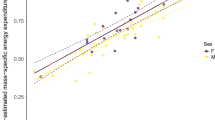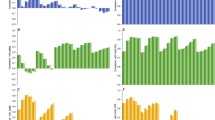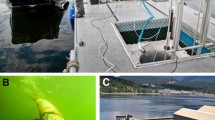Abstract
We tested the ability of overall dynamic body acceleration (ODBA) to predict the rate of oxygen consumption (\(s\dot{V}_{{{\text{O}}_{2} }}\)) in freely diving Steller sea lions (Eumetopias jubatus) while resting at the surface and diving. The trained sea lions executed three dive types—single dives, bouts of multiple long dives with 4–6 dives per bout, or bouts of multiple short dives with 10–12 dives per bout—to depths of 40 m, resulting in a range of activity and oxygen consumption levels. Average metabolic rate (AMR) over the dive cycle or dive bout calculated was calculated from \(s\dot{V}_{{{\text{O}}_{2} }}\). We found that ODBA could statistically predict AMR when data from all dive types were combined, but that dive type was a significant model factor. However, there were no significant linear relationships between AMR and ODBA when data for each dive type were analyzed separately. The potential relationships between AMR and ODBA were not improved by including dive duration, food consumed, proportion of dive cycle spent submerged, or number of dives per bout. It is not clear whether the lack of predictive power within dive type was due to low statistical power, or whether it reflected a true absence of a relationship between ODBA and AMR. The average percent error for predicting AMR from ODBA was 7–11 %, and standard error of the estimated AMR was 5–32 %. Overall, the extensive range of dive behaviors and physiological conditions we tested indicated that ODBA was not suitable for estimating AMR in the field due to considerable error and the inconclusive effects of dive type.




Similar content being viewed by others
Abbreviations
- Mb :
-
Body mass (kg)
- ODBA:
-
Overall dynamic body acceleration averaged over dive cycle or dive bout (g, 1 g = 9.81 m s2)
- \(V_{{{\text{O}}_{2} }}\) :
-
Total oxygen consumption
- \(\dot{V}_{{{\text{O}}_{2} }}\) :
-
Whole animal rate of oxygen consumption rate (ml O2 min−1)
- \(s\dot{V}_{{{\text{O}}_{2} }}\) :
-
Mass-corrected rate of oxygen consumption rate (ml O2 min−1 kg−0.75)
- MRs:
-
Surface metabolic rate ~2 min prior to diving (ml O2 min−1 kg−0.75)
- AMR:
-
Average metabolic rate over dive cycle or dive bout calculated from \(s\dot{V}_{{{\text{O}}_{2} }}\) (ml O2 min−1 kg−0.75)
- DLW:
-
Doubly labeled water
- cADL:
-
Calculated aerobic dive limit
- Dive cycle:
-
Single dive + 1 surface interval until \(s\dot{V}_{{{\text{O}}_{2} }}\) within 5 % of pre-dive MRs
- Dive bout:
-
Series of dives + surface intervals until final \(s\dot{V}_{{{\text{O}}_{2} }}\) within 5 % of pre-dive MRs. Surface intervals within a dive bout do not return to within 5 % of MRs
- Bout of short dives:
-
10 or 12 dives per dive bout; goal of 1–2 min per dive
- Bout of long dives:
-
4–6 dives per dive bout; goal of 4–6 min per dive
- Single dives:
-
1 dive cycle with a dive duration goal of 4–6 min
References
Bengtson JL, Stewart BS (1992) Diving and haulout behavior of crabeater seals in the Weddell Sea, Antarctica, during March 1986. Polar Biol 12:635–644
Boyd IL, Woakes AJ, Butler PJ, Davis RW, Williams TM (1995) Validation of heart rate and doubly labelled water as measures of metabolic rate during swimming in California sea lions. Funct Ecol 9:151–160
Boyd IL, Bowen WD, Iverson SJ (2010) Marine mammal ecology and conservation: a handbook of techniques. Oxford University Press, Oxford
Brown JH, West GB (2005) The origin of allometric scaling laws in biology from genomes to ecosystems: towards a quantitative unifying theory of biological structure and organization. J Exp Biol 208:1575–1592
Castellini MA (1992) Metabolic rates of freely diving Weddell seals: correlations with oxygen stores, swim velocity and diving duration. J Exp Biol 165:181–194
Costa DP, Gales NJ (2000) Foraging energetics and diving behavior of lactating New Zealand sea lions, Phocarctos hookeri. J Exp Biol 203:3655–3665
Costa DP, Gales NJ (2003) Energetics of a benthic diver: seasonal foraging ecology of the Australian sea lion, Neophoca cinerea. Ecol Monogr 73:27–43
Dalton AJ, Rosen DAS, Trites AW (2014) Season and time of day affect the ability of accelerometry and the doubly labeled water methods to measure energy expenditure in northern fur seals (Callorhinus ursinus). J Exp Mar Biol Ecol 452:125–136
Enstipp MR, Ciccione S, Gineste B, Milbergue M, Ballorain K, Ropert-Coudert Y, Kato A, Plot V, Georges J-Y (2011) Energy expenditure of freely swimming adult green turtles (Chelonia mydas) and its link with body acceleration. J Exp Biol 214:4010–4020
Fahlman A, Svärd C, Rosen DAS, Jones DR, Trites AW (2008a) Metabolic costs of foraging and the management of O2 and CO2 stores in Steller sea lions. J Exp Biol 211:3573–3580
Fahlman A, Wilson RP, Svärd C, Rosen DAS, Trites AW (2008b) Activity and diving metabolism correlate in Steller sea lion Eumetopias jubatus. Aquat Biol 2:75–84
Fahlman A, Svärd C, Rosen DAS, Wilson R, Trites AW (2013) Activity as a proxy to estimate metabolic rate and to partition the metabolic cost of diving vs. breathing in pre-and post-fasted Steller sea lions. Aquat Biol 18:175–184
Fedak MA, Pullen MR, Kanwisher J (1988) Circulatory responses of seals to periodic breathing: heart rate and breathing during exercise and diving in the laboratory and open sea. Can J Zool 66:53–60
Gałecki A, Burzykowski T (2013) Linear mixed-effects models using R: a step-by-step approach. Springer, New York
Gerlinsky CD, Rosen DAS, Trites AW (2013) High diving metabolism results in a short aerobic dive limit for Steller sea lions (Eumetopias jubatus). J Comp Physiol B 183:699–708
Gleiss AC, Wilson RP, Shepard EL (2011) Making overall dynamic body acceleration work: on the theory of acceleration as a proxy for energy expenditure. Methods Ecol Evol 2:23–33
Green JA, Butler PJ, Woakes AJ, Boyd IL, Holder RL (2001) Heart rate and rate of oxygen consumption of exercising macaroni penguins. J Exp Biol 204:673–684
Green JA, Halsey LG, Wilson RP, Frappell PB (2009) Estimating energy expenditure of animals using the accelerometry technique: activity, inactivity and comparison with the heart-rate technique. J Exp Biol 212:471–482
Halsey LG, Green JA, Wilson RP, Frappell PB (2008) Accelerometry to estimate energy expenditure during activity: best practice with data loggers. Physiol Biochem Zool 82:396–404
Halsey L, White C, Enstipp M, Wilson R, Butler P, Martin G, Gremillet D, Jones D (2011a) Assessing the validity of the accelerometry technique for estimating the energy expenditure of diving double-crested cormorants Phalacrocorax auritus. Physiol Biochem Zool 84:230–237
Halsey LG, Jones TT, Jones DR, Liebsch N, Booth DT (2011b) Measuring energy expenditure in sub-adult and hatchling sea turtles via accelerometry. PLoS One 6:e22311
Halsey LG, Shepard EL, Wilson RP (2011c) Assessing the development and application of the accelerometry technique for estimating energy expenditure. Comp Biochem Physiol A 158:305–314
Hastie GD, Rosen DAS, Trites AW (2006) Studying diving energetics of trained Steller sea lions in the open ocean. In: Trites AW, Atkinson S, DeMaster DP, Fritz LW, Gelatt TS, Rea LD, Wynne KM (eds) Sea lions of the world. Alaska Sea Grant College Program, University of Alaska Fairbanks, Fairbanks, pp 193–204
Hoenig JM, Heisey DM (2001) The abuse of power: the pervasive fallacy of power calculations for data analysis. Am Stat 55:19–24
King AM, Loiselle DS, Kohl P (2004) Force generation for locomotion of vertebrates: skeletal muscle overview. IEEE J Oceanic Eng 29:684–691
Kooyman GL, Ponganis PJ (1998) The physiological basis of diving to depth: birds and mammals. Annu Rev Physiol 60:19–32
Kooyman GL, Kerem DH, Campbell WB, Wright JJ (1973) Pulmonary gas exchange in freely diving Weddell seals Leptonychotes weddelli. Respir Physiol 17:283–290
Liwanag HEM, Williams TM, Costa DP, Kanatous SB, Davis RW, Boyd IL (2009) The effects of water temperature on the energetic costs of juvenile and adult California sea lions (Zalophus californianus): the importance of skeletal muscle thermogenesis for thermal balance. J Exp Biol 212:3977–3984
Lyons G, Halsey L, Pope E, Eddington J, Houghton J (2013) Energy expenditure during activity in the American lobster Homarus americanus: correlations with body acceleration. Comp Biochem Physiol A 166:278–284
McPhee JM, Rosen DAS, Andrews RD, Trites AW (2003) Predicting metabolic rate from heart rate in juvenile Steller sea lions Eumetopias jubatus. J Exp Biol 206:1941–1951
Merrick RL, Loughlin TR (1997) Foraging behavior of adult female and young-of-the-year Steller sea lions in Alaskan waters. Can J Zool 75:776–786
Packard G, Boardman T (1999) The use of percentages and size-specific indices to normalize physiological data for variation in body size: wasted time, wasted effort? Comp Biochem Physiol Part A 122:37–44
Payne NL, Gillanders BM, Seymour RS, Webber DM, Snelling EP, Semmens JM (2011) Accelerometry estimates field metabolic rate in giant Australian cuttlefish Sepia apama during breeding. J Anim Ecol 80:422–430
Pinheiro JC, Bates DM (2000) Mixed-effects models in S and S-PLUS. Springer, New York
Ponganis PJ, Kooyman GL, Castellini MA (1993) Determinants of the aerobic dive limit of Weddell seals: analysis of diving metabolic rates, postdive end tidal PO2’s, and blood and muscle oxygen stores. Physiol Zool 66:732–749
Rosen DAS, Trites AW (1997) Heat increment of feeding in Steller sea lions, Eumetopias jubatus. Comp Biochem Physiol Part A 118A:877–881
Rosen DAS, Trites AW (2003) No evidence for bioenergetic interaction between digestion and thermoregulation in Steller sea lions Eumetopias jubatus. Physiol Biochem Zool 76:899–906
Rosen DAS, Gerlinsky CD, Trites AW (2015) Evidence of partial deferment of digestion during diving in Steller sea lions (Eumetopias jubatus). J Exp Mar Biol Ecol. doi:10.1016/j.jembe.2015.04.017
Savage VM, Allen AP, Brown JH, Gillooly JF, Herman AB, Woodruff WH, West GB (2007) Scaling of number, size, and metabolic rate of cells with body size in mammals. Proc Natl Acad Sci 104:4718–4723
Schmidt-Nielsen K (1975) Scaling in biology: the consequences of size. J Exp Zool 194:287–307
Shaffer SA, Costa DP, Williams JD, Ridgway SH (1997) Diving and swimming performance of white whales, Delphinapterus leucas: an assessment of plasma lactate and blood gas levels and respiratory rates. J Exp Biol 200:3091–3099
Shepard EL, Wilson RP, Quintana F, Laich AG, Liebsch N, Albareda DA, Halsey LG, Gleiss A, Morgan DT, Myers AE (2008) Identification of animal movement patterns using tri-axial accelerometry. Endanger Species Res 10:47–60
Shepard EL, Wilson RP, Quintana F, Laich AG, Forman DW (2009) Pushed for time or saving on fuel: fine-scale energy budgets shed light on currencies in a diving bird. Proc R Soc B: Biol Sci 276:3149–3155
Sparling CE, Fedak MA (2004) Metabolic rates of captive grey seals during voluntary diving. J Exp Biol 207:1615–1624
Sparling CE, Thompson D, Fedak MA, Gallon SL, Speakman JR (2008) Estimating field metabolic rates of pinnipeds: doubly labelled water gets the seal of approval. Funct Ecol 22:245–254
Speakman J (1997) Doubly labelled water: theory and practice. Springer, Berlin
Staniland I, Boyd I, Reid K (2007) An energy–distance trade-off in a central-place forager, the Antarctic fur seal (Arctocephalus gazella). Mar Biol 152:233–241
Thomas L (1997) Retrospective power analysis. Conserv Biol 11:276–280
Trillmich F, Kooyman GL (2001) Field metabolic rate of lactating female Galápagos fur seals (Arctocephalus galapagoensis): the influence of offspring age and environment. Comp Biochem Physiol Part A: Mol Integr Physiol 129:741–749
White CR, Seymour RS (2005) Allometric scaling of mammalian metabolism. J Exp Biol 208:1611–1619
Williams TM, Kooyman GL, Croll DA (1991) The effect of submergence on heart rate and oxygen consumption of swimming seals and sea lions. J Comp Physiol B 160:637–644
Williams TM, Fuiman LA, Horning M, Davis RW (2004) The cost of foraging by a marine predator, the Weddell seal Leptonychotes weddelli: pricing by the stroke. J Exp Biol 207:973–982
Wilson RP, White CR, Quintana F, Halsey LG, Liebsch N, Martin GR, Butler PJ (2006) Moving towards acceleration for estimates of activity specific metabolic rate in free living animals: the case of the cormorant. J Anim Ecol 75:1081–1090
Winship AJ, Trites AW, Rosen DAS (2002) A bioenergetic model for estimating the food requirements of Steller sea lions Eumetopias jubatus in Alaska, USA. Mar Ecol Prog Ser 229:291–312
Withers PC (1977) Measurement of VO2, VCO2, and evaporative water loss with a flow-through mask. J Appl Physiol 42:120–123
Young BL, Rosen DAS, Haulena M, Hindle AG, Trites AW (2010) Environment and digestion change the ability of heart rate to predict metabolism in resting Steller sea lions (Eumetopias jubatus). J Comp Physiol B 181:105–116
Young BL, Rosen DAS, Hindle A, Haulena M, Trites AW (2011) Dive behaviour impacts the ability of heart rate to predict oxygen consumption in Steller sea lions (Eumetopias jubatus) foraging at depth. J Exp Biol 214:2267–2275
Zar JH (2010) Biostatistical analysis. Pearson Prentice Hall, Upper Saddle River
Zuur AF, Ieno EN, Walker NJ, Saveliev AA, Smith GM (2009) Mixed effects models and extensions in ecology with R. Springer, New York
Acknowledgments
We thank the technicians and the training staff at the UBC Open Water Research Station and the Vancouver Aquarium for assisting with data collection and training the sea lions. We also thank Brian Battaile and Brianna Wright for R code collaboration, and are grateful to Carling Gerlinsky, Alex Dalton, and Elizabeth Goundie for data collection assistance and comments on this manuscript. Financial support was provided by a grant from the North Pacific Marine Science Foundation to the North Pacific Universities Marine Mammal Research Consortium (NA08NMF4390474 and NA11NMF4390124). Graduate support to BLV was provided by a Deakin University Postgraduate Research Scholarship. All data collection was conducted under the UBC Animal Care Permit #A11-0397.
Author information
Authors and Affiliations
Corresponding author
Additional information
Communicated by G. Heldmaier.
Rights and permissions
About this article
Cite this article
Volpov, B.L., Rosen, D.A.S., Trites, A.W. et al. Validating the relationship between 3-dimensional body acceleration and oxygen consumption in trained Steller sea lions. J Comp Physiol B 185, 695–708 (2015). https://doi.org/10.1007/s00360-015-0911-y
Received:
Revised:
Accepted:
Published:
Issue Date:
DOI: https://doi.org/10.1007/s00360-015-0911-y




